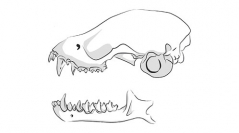

 Comptes Rendus Palevol
15 (5) - Pages 501-514
Comptes Rendus Palevol
15 (5) - Pages 501-514Bats (Chiroptera, Mammalia) are a valuable and independent source of palaeoenvironmental information in Quaternary sites because bat assemblages are not necessarily produced by the same processes as those of other small mammals. Here, we report a small collection of bats (MNI 15) from a cave infill of the Aguilón P7 (AGP-7) site (Zaragoza, Spain) dated Late Pleistocene (MIS 3). This is one of the rare localities south of the Ebro River (right bank) with Neanderthal tracks; therefore, the palaeoenvironmental data provided here may help us to understand Neanderthal history. Nine bat taxa were identified, viz. Rhinolophus ferumequinum, R. hipposideros, Myotis gr. myotis/blythii, M. cf. bechsteinii, M. emarginatus, M. daubentonii, Plecotus gr. auritus/austriacus, Hipsugo savii vel. Pipistrellus kuhlii/nathusii, and Miniopterus schreibersii. The presence of a high number of yearlings of the former four species suggests the presence of breeding colonies. The surprisingly high diversity of the sample indicates a variegated vegetation cover and relatively high humidity for the MIS 3 stage in the region.
Chiroptera, Taxonomy, Taphonomy, Palaeoenvironment, Late Pleistocene